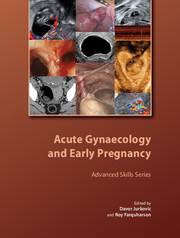Book contents
- Frontmatter
- Contents
- About the authors
- Acknowledgements
- Abbreviations
- Preface
- 1 Organisation and delivery of emergency care in early pregnancy and acute gynaecology
- 2 Epidemiology and aetiology of miscarriage and ectopic pregnancy
- 3 Diagnosis of miscarriage
- 4 Conservative and surgical management of miscarriage
- 5 Management of hyperemesis gravidarum
- 6 Diagnosis and treatment of recurrent miscarriage
- 7 Differential diagnosis and management of molar pregnancy
- 8 Drugs in early pregnancy
- 9 Diagnosis of tubal ectopic pregnancy
- 10 Conservative management of tubal ectopic pregnancy
- 11 Surgical management of tubal ectopic pregnancy
- 12 Diagnosis and management of non-tubal ectopic pregnancy
- 13 Diagnosis and management of acute pelvic pain
- 14 Management of vaginal bleeding in the acute clinical setting
- 15 Current concepts in screening and outpatient management of pelvic inflammatory disease
- 16 Diagnosis and management of haemorrhagic and septic shock
- 17 Role of minimally invasive surgery in acute gynaecology
- Index
14 - Management of vaginal bleeding in the acute clinical setting
Published online by Cambridge University Press: 05 July 2014
- Frontmatter
- Contents
- About the authors
- Acknowledgements
- Abbreviations
- Preface
- 1 Organisation and delivery of emergency care in early pregnancy and acute gynaecology
- 2 Epidemiology and aetiology of miscarriage and ectopic pregnancy
- 3 Diagnosis of miscarriage
- 4 Conservative and surgical management of miscarriage
- 5 Management of hyperemesis gravidarum
- 6 Diagnosis and treatment of recurrent miscarriage
- 7 Differential diagnosis and management of molar pregnancy
- 8 Drugs in early pregnancy
- 9 Diagnosis of tubal ectopic pregnancy
- 10 Conservative management of tubal ectopic pregnancy
- 11 Surgical management of tubal ectopic pregnancy
- 12 Diagnosis and management of non-tubal ectopic pregnancy
- 13 Diagnosis and management of acute pelvic pain
- 14 Management of vaginal bleeding in the acute clinical setting
- 15 Current concepts in screening and outpatient management of pelvic inflammatory disease
- 16 Diagnosis and management of haemorrhagic and septic shock
- 17 Role of minimally invasive surgery in acute gynaecology
- Index
Summary
Introduction
Heavy vaginal bleeding is a common problem, accounting for approximately 70% of referrals to gynaecologists from primary care. Although this condition is usually encountered in an elective outpatient clinic setting, there are occasions when acute bleeding requires emergency hospital admission. Abnormal vaginal bleeding is the second most common reason for presentation to emergency gynaecology units after acute pelvic pain.
This chapter provides a comprehensive overview of non-pregnancy-associated conditions that might present with acute vaginal bleeding. General approaches to management are described, followed by information and advice on managing specific conditions, with key points to be elicited from the history, signs to search for during clinical examination and information on further investigations and treatment. Acute vaginal bleeding can also result from trauma to the genital tract, including trauma arising from sexual assault. Management of such injuries is discussed.
Acute presentation of vaginal bleeding
Abnormally heavy vaginal bleeding is usually uterine in origin (Box 14.1). A thorough clinical history should be taken with particular regard to previous menstrual problems, past investigations and medical or surgical treatment. Women often present with an acute-on-chronic history of heavy vaginal bleeding and may already be taking oral progestogens in a sporadic fashion. Contraceptive history is also relevant as long-acting reversible contraceptives, such as the levonorgestrel-releasing intrauterine system (Mirena®; Bayer Healthcare Pharmaceuticals Inc., Wayne, NJ, USA) or injectable or implanted progestogens, are often associated with breakthrough bleeding in the first few months of use, which can sometimes be heavy.
- Type
- Chapter
- Information
- Acute Gynaecology and Early Pregnancy , pp. 181 - 200Publisher: Cambridge University PressPrint publication year: 2011



